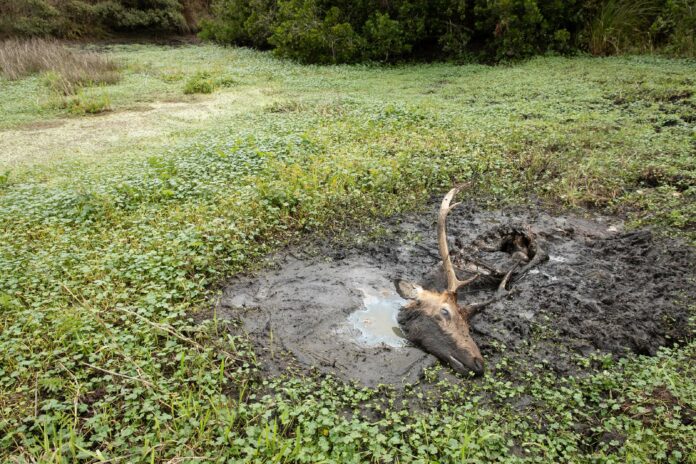The National Park Service (NPS) has revealed that 152 Tule elk recently died under its watch. Tule elk, a species unique to California, once numbered a half million, but were hunted to near extinction when their territory was appropriated for cattle. Now rare, Tule elk can be seen in one national park—Point Reyes National Seashore.
An 8-foot fence surrounds the so-called Tule Elk Reserve at the Seashore to prevent the native elk from eating grass reserved for domestic cattle. The Seashore elk population has declined from 445 last year to 293. The NPS attributes this to poor forage due to drought. None of the 5,700 cattle in the park reportedly succumbed.
The NPS says the elk die-off is a “natural” event”— a normal “population fluctuation” in response to available resources. But there’s nothing “natural” about fencing in wild animals and denying them the food and water they need to survive. This isn’t an act of God. It’s official National Park Service policy: Provide grass and water for cattle. Let wildlife fend for itself.
Last fall, park visitors and wildlife advocates alerted the NPS that water sources in the elk enclosure had dried up, offering photos of elk carcasses as evidence. The NPS dismissed them, insisting there was water. Some 250 elk—half the confined herd—died during the 2012-2015 drought, also a “natural” event in park parlance.
In response, three nonprofit organizations—Resource Renewal Institute, Center for Biological Diversity and Western Watersheds Project—sued the NPS in 2016. The lawsuit was meant to give the public a voice as to whether ranching belongs at the Seashore and under what conditions. A legal settlement committed the NPS to prepare the first-ever Environmental Impact Statement for ranching in the Seashore and to solicit public comments to its plan. Ninety-one percent of the nearly 7,000 public comments opposed continued ranching.
Nevertheless, NPS persisted.
Beef and dairy ranchers hold 24 leases covering approximately a third of the 71,000-acre park. The NPS considers these commercial operations “cultural resources.” Persuaded by politicians and powerful agricultural interests, the NPS sees to it that ranching at the Seashore continues, regardless of environmental impacts or public opposition.
The plan that Seashore ranchers lobbied for, county officials endorsed and the Trump Administration fast-tracked guarantees the ranchers 20-year leases, more livestock, crops and new income streams intended to offset the decline in beef and dairy consumption. Wildlife, the environment and park visitors are shortchanged.
For example, the NPS permits dairies to pump water out of park wetlands to supply cattle—no environmental impact analysis necessary. The plan considers digging wells to supply the water demands of additional livestock and crops—no current data exists on groundwater supplies. In January, an independent lab found extremely high fecal coliform in waters draining the ranches at the Seashore, some showing as much as 40 times the allowable limit for E. coli. Despite data showing chronic water pollution between 1998 and 2005, the NPS rarely tests the water at the dairy ranches.
The latest park superintendent offers his assurances that the Seashore will be better off once his superiors in Washington sign off on the new plan. Never mind that cattle remain the largest source of greenhouse gases at the Seashore; healthy elk will be shot to ensure enough grass for cattle; and Tule elk behind the fence face a long, dry summer.
Susan Ives is co-founder of Restore Point Reyes Seashore in Mill Valley.











